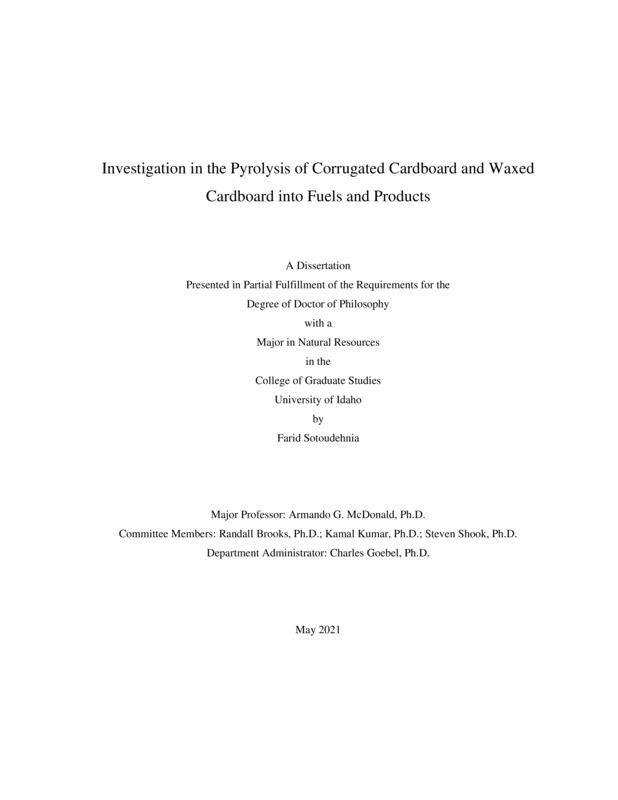Investigation in the Pyrolysis of Corrugated Cardboard and Waxed Cardboard into Fuels and Products
Sotoudehnia, Farid. (2021-05). Investigation in the Pyrolysis of Corrugated Cardboard and Waxed Cardboard into Fuels and Products. Theses and Dissertations Collection, University of Idaho Library Digital Collections. https://www.lib.uidaho.edu/digital/etd/items/sotoudehnia_idaho_0089e_12067.html
- Title:
- Investigation in the Pyrolysis of Corrugated Cardboard and Waxed Cardboard into Fuels and Products
- Author:
- Sotoudehnia, Farid
- Date:
- 2021-05
- Program:
- Natural Resources
- Subject Category:
- Alternative energy; Environmental science
- Abstract:
-
Waste corrugated cardboard and waxed cardboard comprise a substantial portion of municipal solid waste. More than 17 million tons of paper products end up in landfills every year, and this number is expected to grow significantly with the increase in human population in the next few decades. Methods of product and energy recovery from waste can serve as means of not only reducing the environmental and economic impacts of landfilling, but also ensuring sufficient energy resources for future generations. Both waste cardboard and waxed cardboard are suitable resources for thermochemical conversion. Utilizing pyrolysis, a set of experiments was developed to establish waste-to-product and waste-to-energy pathways for cardboard and waxed cardboard. In the first step, waste cardboard was extensively characterized and then pyrolyzed in an auger reactor. The pyrolysis products were characterized. The liquid product (oil) could be used as bunker fuel or further refined to harvest valuable compounds such as levoglucosan. Cardboard solid product (char) was found to be suitable for use in composite materials and as soil amendment. In the second step, waxed cardboard was characterized and pyrolyzed and the pyrolysis products (wax-oil and char) were characterized and analyzed. The wax was effectively recovered. The main compounds found in wax-oil were alkanes, alkenes, and dienes (C9 to C36). Higher pyrolysis temperatures resulted in the breakdown of larger carbon chains into smaller chain alkanes. The wax-oil contained an abundance of long-chain hydrocarbons and small number of oxygenated compounds that made it suitable for further upgrading into fuels. In the final step, the wax-oil samples were thermally and catalytically pyrolyzed on a custom-made small tubular batch reactor, and the resultant liquid products were analyzed against gasoline to evaluate their performance as a transport fuel. The products of thermal pyrolysis of the samples were mainly comprised of dienes and short-chain olefins, oxygenated compounds, and minor amounts of aromatic compounds. Their functional groups resembled those found in paraffin. The catalytic pyrolysis liquid products were similar to gasoline in chemical composition and functional groups and could be used as a “drop in” fuel. The addition of zeolite Y as the catalyst facilitated the conversion of long-chain hydrocarbons to short-chain alkanes and aromatics. The catalyst was able to be recovered and reused, which is an important feature for industrial use in catalytic pyrolysis.
- Description:
- doctoral, Ph.D., Natural Resources -- University of Idaho - College of Graduate Studies, 2021-05
- Major Professor:
- McDonald, Armando G
- Committee:
- Brooks, Randall; Shook, Steven; Kumar, Kamal
- Defense Date:
- 2021-05
- Identifier:
- Sotoudehnia_idaho_0089E_12067
- Type:
- Text
- Format Original:
- Format:
- application/pdf
- Rights:
- In Copyright - Educational Use Permitted. For more information, please contact University of Idaho Library Special Collections and Archives Department at libspec@uidaho.edu.
- Standardized Rights:
- http://rightsstatements.org/vocab/InC-EDU/1.0/

